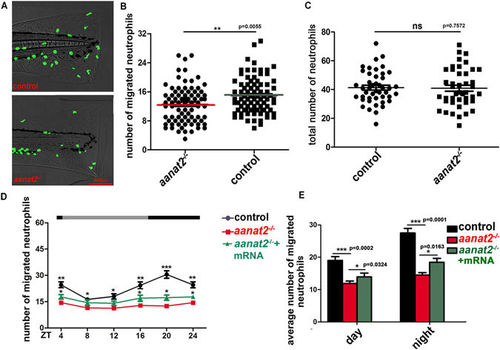Fig. 3
- ID
- ZDB-FIG-170809-23
- Publication
- Ren et al., 2017 - Endogenous melatonin promotes rhythmic recruitment of neutrophils toward an injury in zebrafish
- Other Figures
- All Figure Page
- Back to All Figure Page
|
Neutrophil recruitment was significantly reduced in aanat2 −/− larvae. (A,B) Using a tail fin injury model in Tg(lyz:EGFP);aanat2 −/− zebrafish (4 days), we evaluated the effects of an aanat2 mutant on neutrophil migration at 12:00 in the day. Results showed that aanat2 mutants had significantly decreased neutrophil recruitment (control, n = 90; mutant, n = 90). Neutrophils located at 250 μm from the wound ending were counted and regarded as the valid migration number. The experiment was repeated three times (unpaired t-test analysis). (C) The total number of circulating neutrophils was analyzed by counting fluorescent particles within the 800-μm region from the spinal cord end to the anterior at 12:00. There had no significant difference between the WT/AB (n = 60) and aanat2 mutant groups (n = 60). The experiment was repeated three times (unpaired t-test analysis). Each experiment contains 60 samples. (D) To evaluate the rhythmic migration of neutrophils in aanat2 −/− zebrafish under LD condition, we monitored neutrophil migration at 4-h intervals in a day-night period using a fluorescent microscope. The results showed that rhythmic recruitment of neutrophils was abolished in aanat2 −/− larvae and the migrating neutrophils could be partly rescued by injection of aanat2 capped mRNA (control, n = 30; mutant, n = 30; mutant + mRNA, n = 30). The data was repeated with three independent experiments (ANOVA analysis). Each experiment contains 30 samples. (E) The average number of migrating neutrophils at both day and night was lower in aanat2 −/− compared with wild types (control, n = 90; mutant, n = 90). The data was analyzed from Fig. 3D. ZT: zeitgeber times. (**P < 0.01, ***P < 0.001). |
| Fish: | |
|---|---|
| Condition: | |
| Observed In: | |
| Stage: | Day 4 |

